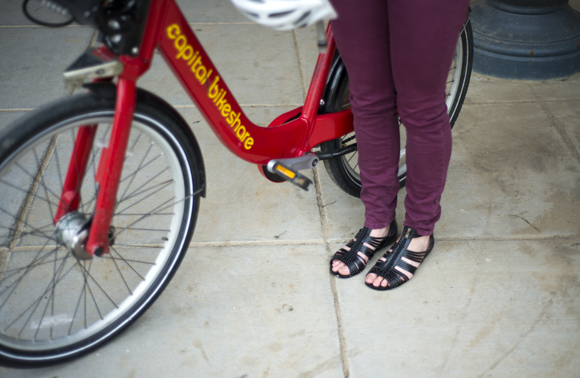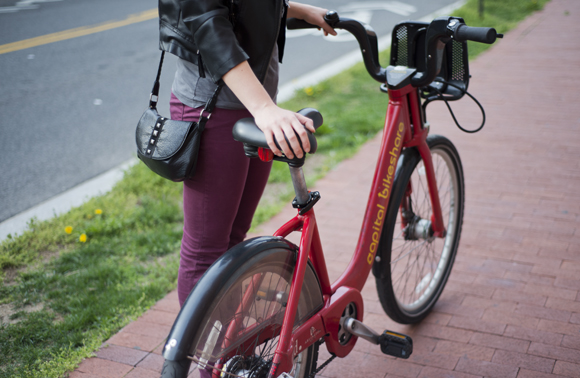Every weekday, hundreds of thousands of commuters drive cars into the District. Metro passengers take 727,000 trips and Metrobus counts over a million boardings.
If that isn’t enough, District residents wanting to get around town can choose from three car-sharing services (Zipcar, Car2Go, and Hertz on Demand), three taxi-hailing apps (MyTaxi, Taxi Magic and Uber), and countless peer-to-peer car services (like RelayRides, SideCar, and RidePost). There’s also the District Department of Transportation's (DDOT) bright red and yellow Capital Bikeshare (CaBi) system, which recently hit the four-million-trip milestone.
Truly, in the last several years, car and bicycle-sharing services have surged in popularity in the District. But why? Experts say that D.C.’s size, demographics, and need to get from point A to point B in a hurry all play a role.
The ‘holy grail’ of the market
Marty Bauer runs
Ridepost, a digital ridesharing board meant to supplant slug lines and the ubiquitous ‘Anyone going to Philadelphia over spring break?’ notes pinned to college dorm bulletin boards. The service is live only for University of South Carolina students and D.C. residents.
"For a transportation company, D.C. is the holy grail of the market."
When the company was choosing a major market to expand into, “we looked at New York, D.C., Chicago, Atlanta.” Bauer says. “Everything always came back to D.C. For a transportation company, D.C. is the holy grail of the market.”
Bauer says that a combination of demographics and economics makes D.C. the ideal testbed for a company like his. Residents living in the city—especially the young, tech-savvy population Ridepost targets--have sold their cars, but they still want to take trips to the beach or to visit friends in other cities and need a way to do so. And people from outside the city who work downtown have to get to work, preferably without sitting in the region's famously bad traffic.
“There’s so many people who commute long distances every day,” Bauer says. “We’ve talked with people from outlying areas like Fredericksburg. I said, ‘There must be a hundred or two hundred people who make this commute.’ They stopped me and said, ‘No, there’s thousands.’”
Pedal Power
Once you’re in the city, far from the domain of megacommuters, the picture brightens a bit, in part thanks to initiatives like
Capital Bikeshare.

H Street resident Maris Fry has been using CaBi since moving to Washington last year, though she owned both a bike and a vehicle. “When I started my job, my coworkers urged me to sign up, saying that it was a great way to get around the city,” says Fry. “I also appreciate the fact that it is open during the winter, unlike many bikeshare systems in other cities. I know I'm not the only one who continued to ride bikeshare throughout the winter months.”
The visibility of the bright-red bikes and ease of navigating D.C. helps make the system more attractive to tourists. “It’s not intimidating or confusing,” Director of D.C.’s Office of Planning Harriet Tregoning says. Yet the stations’ ubiquity makes the bikes useful for residents too. “We’re in almost every location, so it’s super convenient,” she says.
CaBi has over 175 bike stations and has had 40,000 annual members join since 2010 along with 260,000 casual users, according to DDOT's bikesharing project manager Chris Holben. This makes CaBi the largest and most successful bikesharing service in the U.S.
As for a personal thought on Cabi’s attraction, Tregoning says, “I think it’s the one way trip.” With no need to return the bike to a “home” location, users can get home however they like, bad weather or otherwise. “The best kept secret of Washington D.C. is that it’s faster to get around by bike than the Metro, bus, or even driving,” she adds.
"It becomes essential to ensure there are transportation alternatives that help to reduce traffic and parking congestion."
About half of CaBi users renew their memberships, though there's a greater potential for growth as CaBi adds more
bike stations and increases membership in Arlington, Va. and the District. Since D.C. is a fairly transitory town, we get some folks who don't renew as they move away,” says DDOT’s Holben. “We have a bump every spring as new members join.“
Transportation alternatives wanted
That one-way trip may contribute to another newcomer’s success: the Daimler-owned car-sharing company
car2go. More than three hundred tiny, fuel-efficient Smart fortwo cars are now parked all over D.C. for 38-cent-per-minute rentals.
Unlike ZipCar, which requires a return trip to specific parking spots, car2go members can end their reservation anywhere they choose, so long as it’s a legal parking space within the designated D.C. “Home Area.”
In less than a year, car2go has signed on 20,000 D.C. members and collectively taken 350,000 trips, says car2go spokeswoman Katie Stafford.
Car2go initially launched in Austin, Tex., a city with more people and more sprawl. Despite D.C.’s contrast with Austin, car2go has quickly caught on in the nation’s capital.

Stafford says car2go is “not just about population density and car-centric areas...The cities that we are in area all very fast growing. As more and more people move into these cities, it becomes essential to ensure there are transportation alternatives that help to reduce traffic and parking congestion.”
Another factor in the company’s success here, she adds, is a welcoming environment from DDOT and other D.C. agencies.
Fry ultimately ended up selling her car. “I don't think I would have gotten rid of it without the option of car-sharing. The car-sharing program gave me the peace of mind to get rid of my car knowing I had vehicle options in case I really needed one. I think a lot of people in the area feel the same way,” she says.